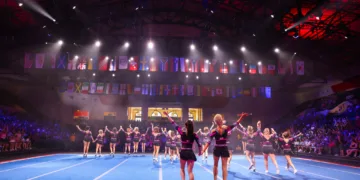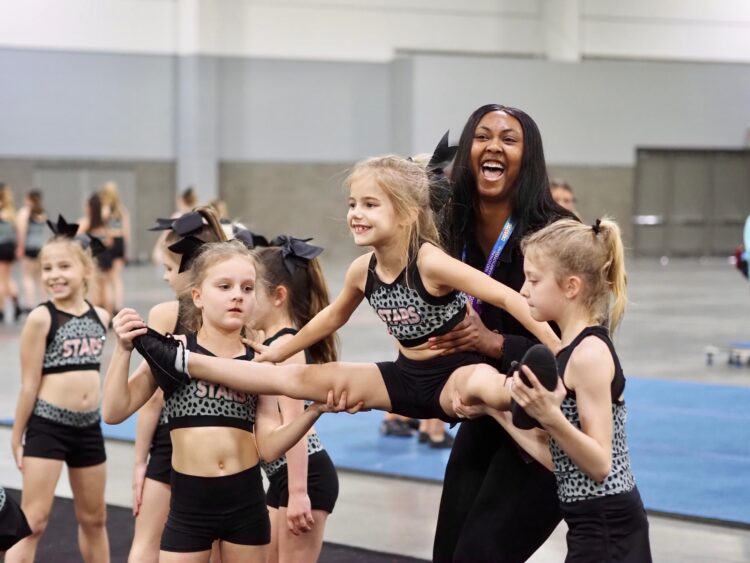Diving into the cheerleading world can be both exciting and a bit confusing, especially with all the different terms and categories. Whether you’re a new cheer parent, an aspiring cheerleader, or just curious, this guide will help you navigate the basics of cheerleading levels, divisions, and how performances are scored.
Levels: What Do They Mean?
Cheerleading levels indicate the complexity of skills in routines. Here’s a quick overview of what to expect at each level:
Level 1 (L1)
- Tumbling: Basic rolls, cartwheels, and round-offs.
- Stunts: Two-legged stunts at prep level.
- Baskets: Straight ride baskets (basic).
- Pyramids: Simple structures at prep level.
Level 2 (L2)
- Tumbling: Handsprings, back walkovers.
- Stunts: Extended one-legged stunts, simple transitions.
- Baskets: Toe touch or pike baskets.
- Pyramids: Extended stunts with basic connections.
Level 3 (L3)
- Tumbling: Multiple handsprings, aerials.
- Stunts: Single-leg extended stunts, full twist dismounts.
- Baskets: Single trick tosses like toe touch.
- Pyramids: More intricate, extended stunts with inversions.
Level 4 (L4)
- Tumbling: Layouts, standing tucks.
- Stunts: Extended one-legged stunts, double twist dismounts.
- Baskets: Double full twists.
- Pyramids: High-flying stunts with release moves.
Level 5 (L5)
- Tumbling: Full twisting layouts, standing fulls.
- Stunts: High difficulty with single-leg extended, double downs.
- Baskets: Double full twists with variations.
- Pyramids: Complex structures with multiple release moves and inversions.
Level 6 (L6)
- Tumbling: Full and double full twists, elite passes.
- Stunts: Advanced with multiple skills combined, double downs.
- Baskets: Triple twists, kick doubles.
- Pyramids: Highly complex with multiple release and inverted skills.
Level 7 (L7)
- Tumbling: Most advanced, including double full twisting passes.
- Stunts: Most complex combinations, elite level.
- Baskets: Triple full twists, kick triples.
- Pyramids: Most advanced with high risk and complexity.
Exploring Novice, Prep, and Elite Divisions
In addition to the basic levels, the cheerleading world includes specific categories like Novice, Prep, and Elite, each with different commitment levels and routine complexities:
- Novice: This category is ideal for beginners. It features very restricted rules with routines lasting only 1:30 minutes. Novice is designed to introduce new athletes to cheerleading fundamentals in a less demanding environment.
- Prep: Serving as an intermediate stage, Prep has fewer restrictions than Novice and features routines that are 2:00 minutes long. This level requires less time, financial, and travel commitments compared to more advanced levels. It’s perfect for those looking to step up from Novice without the full commitment of Elite cheer.
- Elite: Representing the highest level of competitive cheerleading, Elite includes routines that last 2:30 minutes and involve complex skills and choreography. Elite teams often compete at national and international competitions, including exclusive events like The Cheerleading Worlds.
Moreover, gyms that focus solely on Prep routines can still achieve remarkable success. Whether a gym is classified as D1 (large gyms with more than 125 athletes) or D2 (smaller gyms with up to 125 athletes), the level of talent can be extraordinary.
Divisions: Age and Team Size
Divisions categorize teams by age and size, ensuring fair competition. Here are the primary divisions based on age and birth year for the 2024-2025 season:
| Age | Birth Year | Team Size | |
|---|---|---|---|
| Tiny | Ages 6-7 | 2017-2019 | 5-30 |
| Mini | Ages 7-9 | 2015-2018 | 5-30 |
| Youth | Ages 8-12 | 2012-2017 | 5-30 |
| Junior | Ages 9-15 | 2009-2016 | 5-30 |
| Senior | Ages 13-19 | 6/1/05-2012 | 5-30 |
| Senior Open | Ages 18+ | Before 5/31/07 | 5-24 |
Teams can also be classified as Coed (with males) or All-Girl. For more detailed information on divisions and team sizes, refer to the 2023-2024 All Star Rules.
D1 and D2 Explained
- D1 (Division 1): Large gyms with over 125 athletes.
- D2 (Division 2): Smaller gyms with 125 athletes or fewer.
Scoresheets: How Performances Are Judged
Cheerleading competitions use scoresheets to evaluate performances. Here are the key scoring areas:
- Stunts: Difficulty, execution, and creativity.
- Tumbling: Complexity and execution.
- Pyramids: Construction, creativity, and execution.
- Jumps: Height, form, and synchronization.
- Dance: Choreography, synchronization, and energy.
- Overall Performance: Showmanship, transitions, and impact.
For more detailed scoring criteria, visit United Scoring Partners, USASF, the Open Championships Series, and the Varsity All Star Scoring pages.
Putting It All Together
When you see terms like “J6” or “S4,” it’s a mix of age division and skill level. Scoresheets ensure fair judging, covering every aspect of the routine. If you’re still feeling lost, don’t hesitate to ask fellow cheer enthusiasts—they’re always ready to help newcomers! Check out this link for a complete glossary of cheerleading terms.
Whether you’re just starting out in cheerleading or looking to refine your skills, understanding the levels, divisions, and scoring is crucial in navigating your cheer journey. Each category offers unique challenges and opportunities to shine. Remember, the world of cheer is as diverse as it is vibrant—there’s a place for everyone, from the spirited novice to the elite competitor.
Ready to master the art of cheerleading? Dive deeper into the world of cheer with our comprehensive guides and resources. Don’t miss out on becoming an expert — follow Cheer Daily here!






























